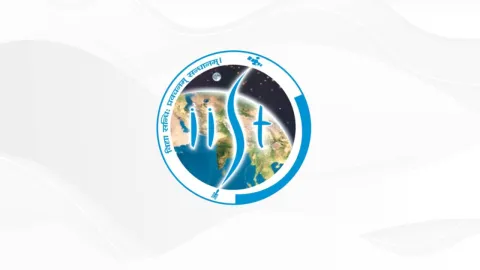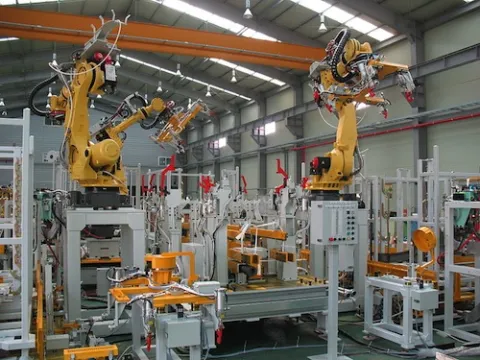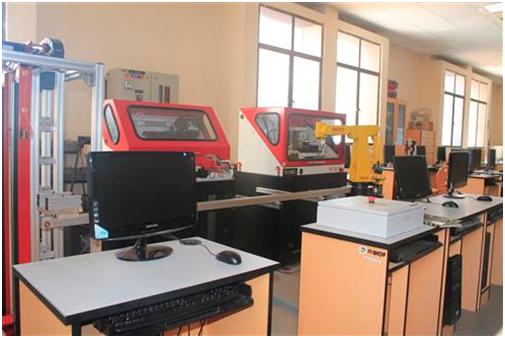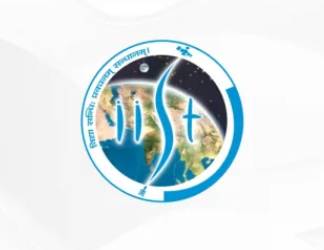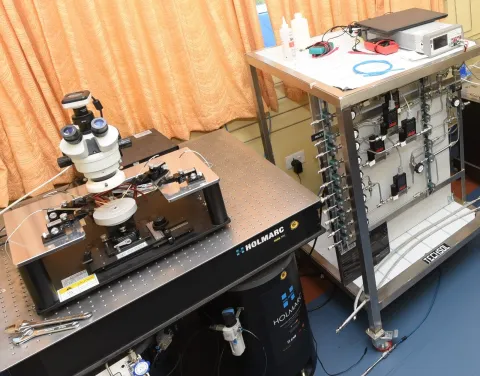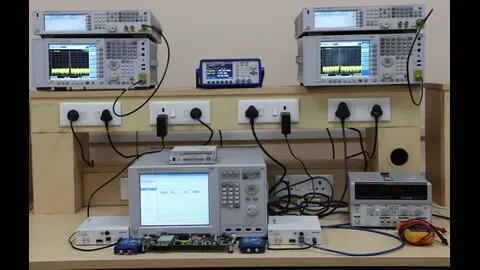In addition to ISRO funded projects, the faculty members of IIST are engaged in externally funded projects from national agencies/society/departments such as DST-SERB, ICSSR, MoES, DBT, Ministry of Electronics and Information Technology -MeitY, DRDO, KSCSTE etc, in the niche areas of space science technology and applications as listed below.
Probing interactions of electrons and their elementary excitations close to Fermi level is of fundamental (as well as of practical relevance) interest to understand the electronic properties in strongly correlated electron systems.
We use spectroscopic Imaging Scanning Tunnelling Microscope (SI-STM) to visualize the quantum realm of these electronic structures both in real space(r-space) and momentum space (k-space).Macro models, post-Keynesian system, global institutions like IMF, World Bank, WTO, BRICS, multi polar macroeconomic system.
Faculty
Some of the prominent research areas pursued by this group are
- Additive & Subtractive Manufacturing
- Design for Manufacturing
- Hot working process
- Friction stir processing
- Sequencing and scheduling
- Membrane for water purification
- Materials for CO2 adsorption
- Materials for EMI shielding
The problems of fundamental interest in control theory are that of controllability, observability and optimal control. We investigate these problems by using efficient tools from the theory of Differential equations and Functional Analysis. We deal with both linear and nonlinear problems.
When the thickness of the elastic body is small, lower dimensional theories have been proposed, depending on mechanical and geometrical nature of the body, as approximations of usual three-dimensional theory. But it is not evident which is the model most suited to a particular case in mind. Consequently, before approximating the exact solution of a given lower dimensional model, we should first know whether it is “close enough” to the exact solution of the three-dimensional model it is intended to approximate. Thus one is lead to the question of mathematically justifying lower-dimensional models starting from the three-dimensional model.
- Nanomaterials and nanocomposites
- EMI shielding Materials
- Nanocomposites for structural applications
New product development is the process of evolving a new product or service for the market. It is the preliminary step in product or service development and involves a number of steps that must be completed before the product can be introduced into the market. Improving and updating products is an ongoing task as the needs and requirements of customers’ changes on a continuous basis. Research areas of study in department include feasibility studies, product analysis, product design and development, marketing and commercialization of product.
Faculty
Numerical analysis focuses on developing and analyzing algorithms to find approximate numerical solutions to mathematical problems. Most of the cases the exact solutions are difficult or impossible to obtain, which is common in many scientific and engineering applications. Numerical analysis provides the tools to design and analyze methods for solving problems like finding roots of equations, solving systems of equations, approximating integrals and derivatives, and solving differential equations.
- Computational design and development of theranostic agents
- Combinatorial chemistry, drug discovery and drug delivery
- Self assembled molecular architectures
- Polymeric drug conjugates, nanogels and polyelectrolyte complexes
This group has four faculty members working in different specialized areas of Power Electronics and Power Systems. Major areas of research are:
- Power Converters
- Control of Electric Drives
- E-mobility
- Smart Grid
- Distributed Generation
- Renewable Energy
- Space Power Systems
As the objective of development is to create an enabling environment for people to enjoy a productive, healthy, and creative life, it is important to address the issue of marginalization. Development is always broadly conceived in terms of mass participation. Marginalization deprives a large majority of people across the globe from participating in the development. It is a complex problem, and there are many factors that cause marginalization. This complex and serious problem need to be addressed at the policy level. This project deals with the problems associated with the groups suffering from marginalization and the ways to reduce them.
Faculty
Quantum Information and Quantum Optics
Research activities being carried out in Quantum optics and Quantum Information include the exploration of methods to generate and detect entanglement in photons, and also studying the role of quantum noise in quantum information processing.
Quantum Optical Technology Lab (QOTL)
The Quantum Optical Technology Lab (QOL) of IIST is established to perform the experimental research activities in several forefront areas of quantum optical technologies. Currently, the QOTL is involved in the following research activities:
Generation and Characterization of Quantum Squeezed/Entangled Light beams Quantum Sensing, Quantum Metrology and Quantum Imaging Engineering Spatial Quantum Correlations for Quantum Cryptography and Quantum Communication.
The lab is equipped with a high-power continuous wave titanium sapphire laser, a Tunable diode laser, spectrum analyzers, spatial light modulator, an EMCCD camera and several types of photodetectors, including single photon counting modules.
Dr. Ashok Kumar (Associate professor, Physics) leads the research lab, where, currently, four regular PhD students, two master students and two undergraduate students are performing the research activities.
In a data-driven era, geospatial information has become an essential asset, applicable in areas such as urban planning and the monitoring of environmental and natural resources. This data offers vital insights into the spatial aspect of information, facilitating informed decision-making across various sectors. The growing complexity of global issues—like urbanization, climate change, disaster management, and natural resource oversight—has heightened the necessity for precise and timely geospatial data.
The Remote Sensing Group within the Department of Earth and Space Sciences consists of three faculty members dedicated to analyzing geospatial data and advancing geoinformatics. Their research emphasizes the development of innovative methods and techniques for processing and interpreting data obtained from a diverse array of geospatial sensors, including Unmanned Aerial Vehicles (UAVs), ground-based systems, and satellite platforms.
The group extensively utilizes data from multispectral, hyperspectral imaging, microwave, LiDAR, and other remote sensing technologies to tackle real-world challenges. Their research encompasses various application domains, such as agriculture, urban studies, coastal zone monitoring, and disaster management. By integrating sophisticated geospatial analytics, machine learning techniques, and multi-sensor data fusion, the Remote Sensing Group makes significant contributions to both scientific research and practical solutions aimed at sustainable development and environmental management.
Beyond research, the group is instrumental in providing the M.Tech program in Geoinformatics, which has been successfully operating since 2013. With an annual enrollment of 10 students, the program draws candidates from open channels as well as from organizations like ISRO and DRDO. Graduates of this program often secure positions in leading geospatial organizations.
The group is also actively involved in several externally funded research projects, supported by national agencies and organizations. These projects focus on cutting-edge technologies and address pressing real-world problems, including climate resilience, smart agriculture, urban sustainability, coastal ecosystem monitoring and disaster preparedness.
Through a blend of cutting-edge research and academic excellence, the Remote Sensing Group continues to contribute to the advancement of geospatial technologies for sustainable development and scientific discovery.
Key Research Areas:
Studying Geoinformatics at IIST
The M. Tech in Geoinformatics program at the Indian Institute of Space Science and Technology (IIST) is designed to provide in-depth knowledge and practical skills in the field of geospatial science and technology. The program admits 10 students annually, including open category and sponsored candidates. The admission is through valid GATE score as given in the IIST admission portal Graduates of the program have an excellent track record, finding placements in leading geospatial companies, government agencies, and research institutions, or pursuing doctoral studies in India and abroad. The program prepares students to be at the forefront of geospatial innovation, contributing to national development and global scientific advancement.
The group has faculty members working in various specialized areas of microwave circuits and systems, planar circuits, antennas and meta-materials. Major areas of research currently this group is dealing with are:
- Microwave Circuits
- Metamaterial Inspired Circuit and Antennas
- Ultra Wide Band Antennas
- Dielectric Resonator and Antennas
- RF and Microwave communication systems
It analyse how technological revolution affects society, the daily life in time allocation patterns, in the choice of social functions, in the transmittal of cultural values, and in overall human behavior.
Faculty
The group has 2 faculty members working in various specialized areas of micro-nano fabrication, modeling etc. Major areas of research currently control group is dealing with are:
- VLSI design
- IC Design, sub-threshold design methodology and system implementation
- Very low voltage circuits for wireless sensor Networks & Biomedical signal processing
- Signal processing hardware for color image processing, image analysis, object recognition
- Analog IC design
- Fault tolerant computing
The group has faculty members working in various specialized areas of signal processing, communication, image processing etc. Major areas of research currently this group is dealing with are:
- Reinforcement Learning
- Communication Networks
- Neuro Fuzzy Systems
- Computer Vision and Object Recognition
- Image compression
- Signal processing for 5G and 6G communication system
- Three dimensional object Recognition
- Robotic Vision
- Architectures for signal/Image processing
- Modeling virtual reality environments for space applications
Social Surveys about social problems, need assessment surveys and to understand the finer fabric of society is undertaken.
Faculty



